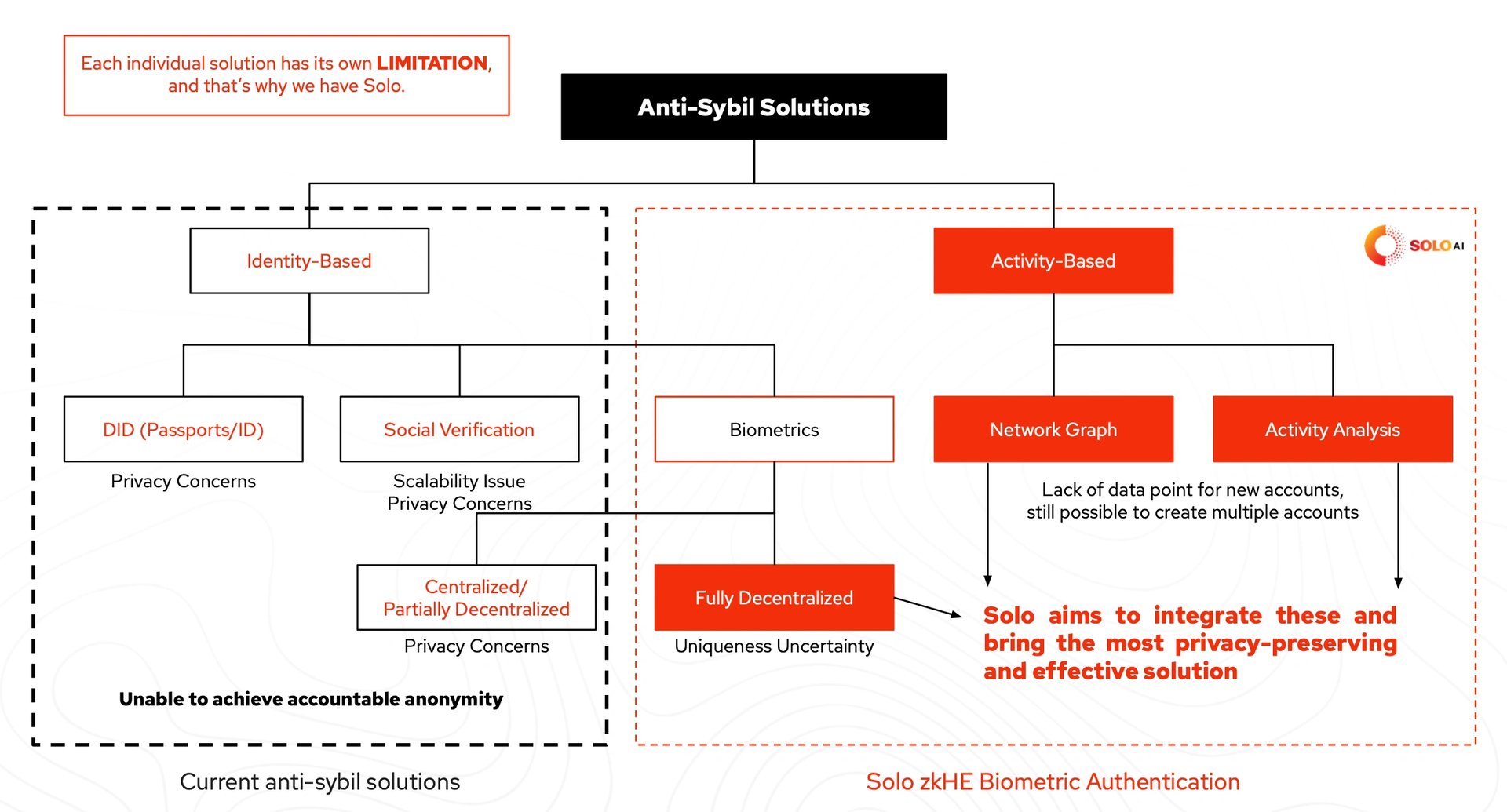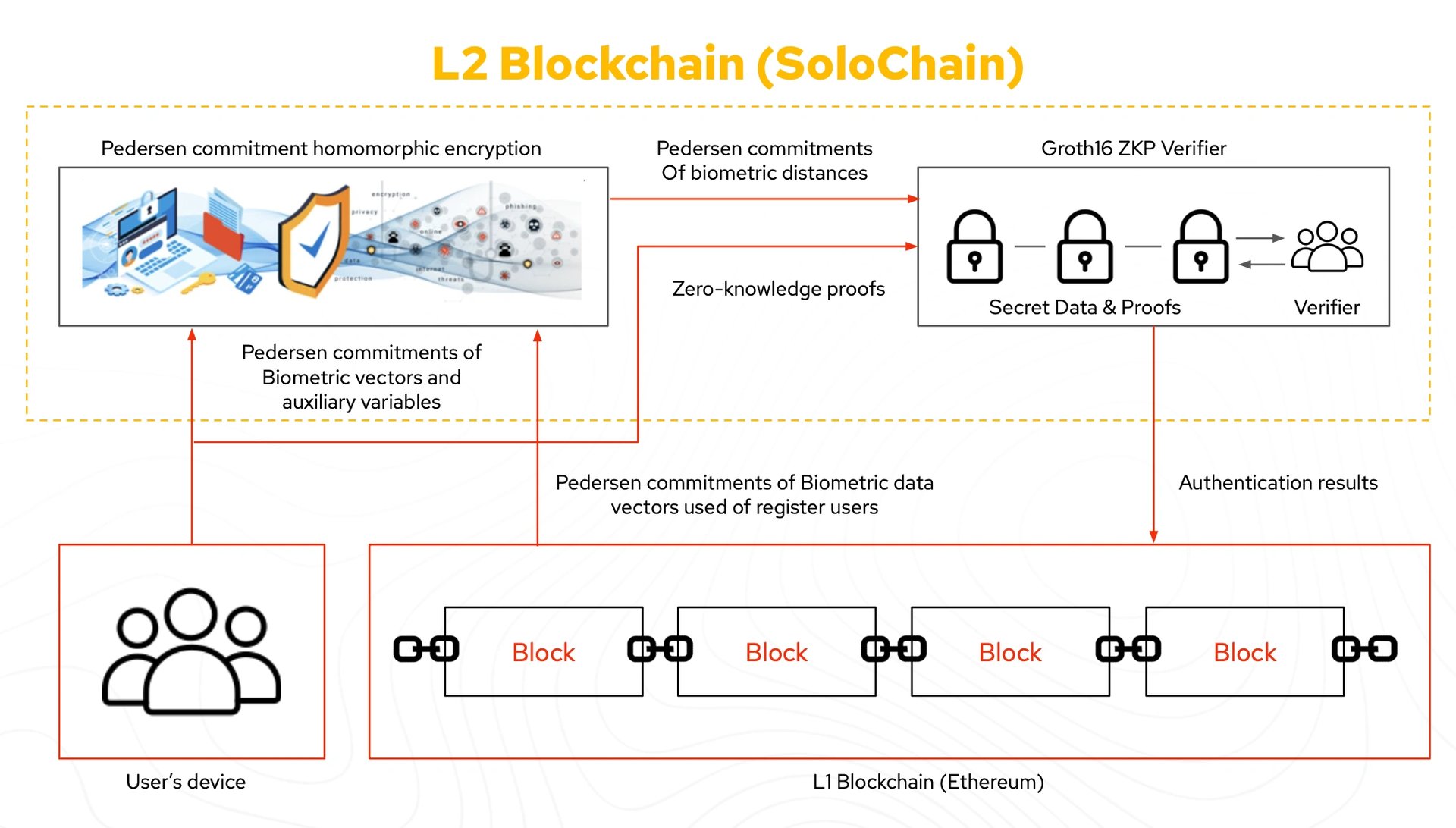위키 구독하기
Share wiki
Bookmark
Solo
Solo
Solo는 분산형 애플리케이션(dApps)(https://iq.wiki/wiki/decentralized-application)과의 상호 작용 중에 사용자가 실제 사람임을 지속적으로 확인하여 시빌 공격 방어 기능을 강화하고자 합니다. 이 방법은 봇 간섭과 AI 오염을 제거하여 디지털 상호 작용의 무결성을 향상시키는 것을 목표로 합니다.[1]

개요
Solo는 지속적이고 분산된 생체 인증을 통해 시빌 공격 방어 기능을 향상시키는 것을 목표로 합니다. 1인 1계정(1P1A) 프레임워크를 활용하여 진정한 사용자 참여를 보장하고 데이터 노출을 최소화하고자 합니다.
Solo는 zkHE 생체 인증 시스템을 통해 분산형 애플리케이션(dApps)(https://iq.wiki/wiki/decentralized-application)과의 상호 작용 중에 실제 사람임을 확인하여 봇 간섭과 AI 오염을 제거하고자 하며, 개인 정보 보호와 정확성의 균형을 맞추고자 합니다.
사용자에게는 원활한 인증, 향상된 개인 정보 보호 및 책임 있는 익명성을 제공합니다. 프로젝트의 경우 봇 및 가짜 계정을 방지하고, 데이터 품질을 보장하며, dApp 사용 중 지속적인 인증을 제공하는 것을 목표로 합니다.[1]
지속적인 인증
Solo의 지속적인 인증 시스템은 주기적인 재인증 및 자동 로그아웃을 요구하여 dApp 사용자가 실제 사람임을 보장하는 것을 목표로 합니다. 모든 모바일 기기를 지원하며 홍채 스캐닝과 같은 하드웨어 제한을 피하고자 합니다.
Web3 게임의 경우, 부정 행위를 방지하고 공정한 게임을 지원하는 것을 목표로 합니다. 데이터 라벨링의 경우, 작업이 사람에 의해 완료되었음을 확인하여 AI 모델의 무결성을 유지하는 것을 목표로 합니다. [1]

제품
SoloChain
SoloChain은 Pedersen 커밋 기반 동형 암호화 및 Groth 16 영지식 증명을 사용하여 개인 정보 보호 기능을 향상시키는 것을 목표로 하는 레이어-2 솔루션입니다. 생체 인식 거리 및 벡터를 포함한 생체 인식 데이터를 안전하게 관리하고 확인하도록 설계되었습니다. SoloChain은 이더리움과 같은 레이어-1 블록체인 위에서 작동하며 민감한 데이터 및 증명 처리의 개인 정보 보호 및 효율성을 향상시키는 것을 목표로 합니다.[1]

아키텍처
ZKHE 인증
Solo 플랫폼은 개인 정보 보호에 중점을 둔 레이어-2 솔루션인 SoloChain의 지원을 받는 zkHE 인증 아키텍처를 기반으로 합니다. 이 시스템은 Pedersen 커밋 동형 암호화, 영지식 증명 및 AI 분석을 사용하여 모든 모바일 기기에서 실제 사용자를 지속적으로 확인하고 확장성과 개인 정보 보호의 균형을 맞추는 것을 목표로 합니다.[1]
Groth 16 zk-SNARK ZKP
Groth 16 zk-SNARK ZKP는 사용자 데이터를 비공개로 유지하면서 블록체인 트랜잭션을 확인하는 것을 목표로 합니다. 재귀적 ZKP를 사용하여 Pedersen 커밋 기반 동형 암호화와 Groth 16 zk-SNARK를 결합하여 암호화된 계산 중 블록체인 오버헤드를 최소화합니다. 이 방법은 데이터 개인 정보 보호를 유지하고 세부 정보를 공개하지 않고 계산 무결성을 확인하는 것을 목표로 합니다.[1]
Pedersen 커밋 기반 동형 암호화
Pedersen 커밋 기반 동형 암호화는 인증 전반에 걸쳐 생체 인식 데이터를 암호화하여 데이터 기밀성을 보장하고 계산 중 개인 정보를 보호하는 것을 목표로 합니다. 또한 생체 인식 데이터 형식을 정규화하여 ZKP 회로 설계를 단순화함으로써 오프체인 계산 요구 사항을 줄이는 것을 목표로 합니다.[1]
FIDO
FIDO는 생체 인식 인증 및 암호화 키 관리를 위한 국제 표준입니다. 기존 암호 대신 생체 인식 및 암호화 방법을 사용하여 비밀번호 없는 인증을 용이하게 하는 것을 목표로 합니다.[1]
팀
- Edison Siu: CEO
- Prof. Stephen Wang: zk-SNARK 및 암호화 연구원
- Prof. Sissi Wu: AI 및 데이터 과학 연구원[1]
잘못된 내용이 있나요?
